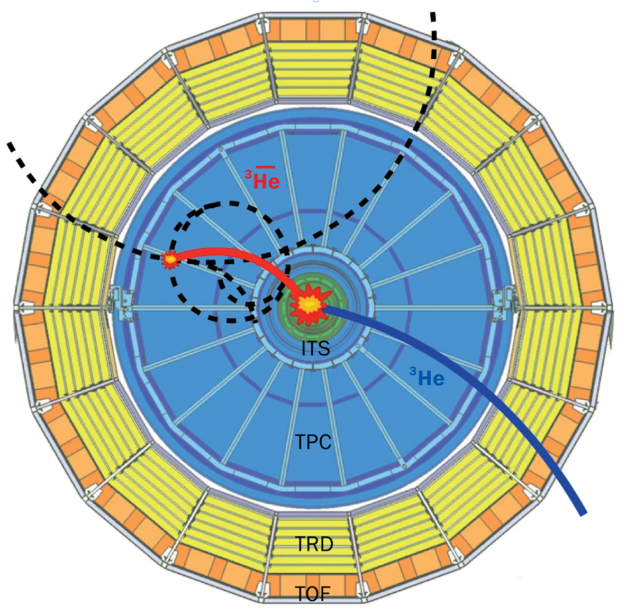
Antinuclei can travel vast distances through the Milky Way without being absorbed, concludes a novel study by the ALICE collaboration. The results, published in December, indicate that the search for 3He in space is a highly promising way to probe dark matter.
First observed in 1965 in the form of the antideuteron at CERN’s Proton Synchrotron and Brookhaven’s Alternating Gradient Synchrotron, antinuclei are exceedingly rare. Since they annihilate on contact with regular matter, no natural sources exist on Earth. However, light antinuclei have been produced and studied at accelerator facilities, including recent precision measurements of the mass difference between deuterons and antideuterons and between 3He and 3He by ALICE, and between the hypertriton and antihypertriton by the STAR collaboration at RHIC.
Antinuclei can in principle also be produced in space, for example in collisions between cosmic rays and the interstellar medium. However, the expected production rates are very small. A more intriguing possibility is that light antinuclei are produced by the annihilation of dark-matter particles. In such a scenario, the detection of antinuclei in cosmic rays could provide experimental evidence for the existence of dark-matter particles. Space-based experiments such as AMS-02 and PAMELA, along with the upcoming Antarctic balloon mission GAPS, are among a few experiments that are able to detect light antinuclei. But to be able to interpret future results, precise knowledge of the production and disappearance probabilities of antinuclei is vital.
The latter is where the new ALICE study comes in. The unprecedented energies of proton–proton and lead–lead collisions at the LHC produce, on average, as many nuclei as antinuclei. By studying the change in the rate of 3He as a function of the distance to the production point, the collaboration was able to determine the inelastic cross section, or disappearance probability, of 3He nuclei for the first time. These values were then used as input for astrophysics simulations.
Two models of the 3He flux expected near Earth after the nuclei’s journey from sources in the Milky Way were considered: one assumes that the sources are cosmic-
ray collisions with the interstellar medium, and the other annihilations of hypothetical weakly interacting massive particles (WIMPs). For each model, the Milky Way’s transparency to 3He – that is, its ability to let the nuclei through without being absorbed – was estimated. The WIMP dark-matter model led to a transparency of about 50%, whereas for the cosmic-ray model the transparency ranged from 25 to 90%, depending on the energy of the antinucleus. These values show that 3He originating from dark-matter or cosmic-ray collisions can travel distances of several kiloparsecs in the Milky Way without being absorbed, even from as far away as the galactic centre.
“This new result illustrates the close connection between accelerator-based experiments and observations of particles produced in the cosmos,” says ALICE spokesperson Marco van Leeuwen. “In the near future, these studies will be extended to 4He and to the lower-momentum region with much larger datasets.”
Further reading
ALICE Collab. 2023 Nat. Phys. 19 61.







